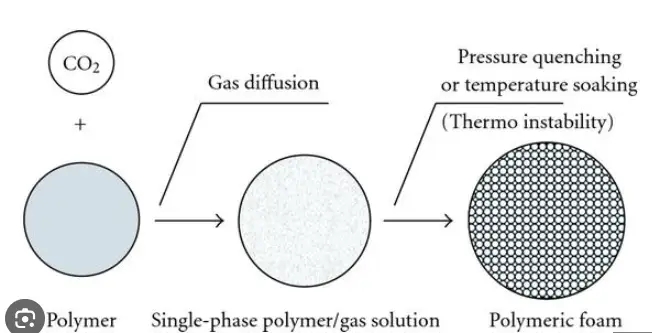Why supercritical foam technology is becoming more and more popular?
With the growing enhancement of environmental consciousness, an increasing number of companies are directing their attention towards sustainable development and exploring more eco-friendly production methods.
The developed countries in Europe have replaced the freons (142b and 22) used in XPS production with CO2 as early as 2002. The United States also stopped using F142b and F22 in 2010.
As China pays more attention to environmental issues and the government needs to fulfill its commitments to the world when it joined the Montreal Protocol. The production of freon used in XPS production will be reduced year by year, its price is bound to be higher and higher, and CO2 foaming is bound to become the mainstream of the industry. Supercritical CO2 foaming technology emerges as an environmentally friendly approach capable of significantly reducing waste and environmental harm.

Feininger XPS extruded board production line
Supercritical CO2 foaming involves the use of supercritical fluids to foam plastics. Supercritical fluid, characterized by high viscosity, high density, and strong permeability and lubricity, serves as the medium. Placing a plastic sample into supercritical CO2, rapidly cooling it down, and subsequently lowering the pressure causes the rapid release of CO2 from the plastic. This process leads to the formation of small bubbles in the plastic sample, achieving the desired foaming effect. Importantly, CO2 evaporates quickly from the medium during this process without causing any environmental pollution.
The application of supercritical CO2 foaming extends beyond the production of plastic products to include foam materials and various polymer materials. This technology not only diminishes production waste and CO2 emissions but also contributes to reducing overall production costs.
In contrast to traditional foaming technology, which often employs Freon, a toxic substance released during the foaming process, supercritical CO2 foaming technology represents a novel environmentally friendly approach. This technology minimizes or completely eliminates the use of toxic substances, thereby mitigating environmental pollution and reducing the impact on human health.

Feininger XPS extruded board production line
The difference between supercritical foaming and chemical foaming
Supercritical foaming:
Pure foaming materials are prepared by supercritical foaming, which has the grade of food safety.
Compared with chemical foaming, supercritical foaming has finer cell structure and more stable properties.
The foam with supercritical foaming has higher impact strength, better thermal stability, toughness, good sound insulation, lower thermal conductivity and thermal conductivity.
Long saturation time will affect production efficiency, rapid heating or rapid pressure relief has high requirements for energy and equipment safety.

Chemical foaming (take azodicarbonamide as an example):
The utility model has the advantages of the largest gas generation, relatively uniform bubbles, superior performance and a wide range of applications.
The decomposition temperature is adjustable and does not affect the curing and moulding speed, and the process is very mature.
AC foaming agent is yellow crystal, and decomposition is easy to produce more by-products, such as particle size is not fine enough will lead to more by-products, resulting in taste, color deviation.
Future Development trend of supercritical foaming technology
Supercritical foaming is a new process, in the past, traditional chemical foaming is difficult to achieve lightweight and low-density performance for some materials, but the development of supercritical foaming technology can enable more materials to achieve lightweight and low-density performance. at the same time, it has the advantages of environmental protection and cleanliness, which is also in line with the current development strategy of carbon neutralization.
In the future, as people deepen their understanding of environmental protection issues, the utilization of supercritical CO2 foaming technology is expected to become more widespread. This technology allows us to manufacture products that are both environmentally friendly and sustainable, thereby reducing environmental impact throughout the production process. This, in turn, contributes to human health and fosters future sustainable development.
In essence, supercritical CO2 foaming technology stands as an innovative and eco-friendly approach, enhancing the environmentally friendly and sustainable aspects of our production. Despite the existing challenges that need resolution, I am confident that as technology continues to advance and refine, more individuals and industries will embrace this technology, aligning environmental protection with industrial development harmoniously.

Feininger XPS extruded board production line
Feininger adopts supercritical foam technology to produce XPS foam board
Feininger has been committed to the R & D and production of carbon dioxide XPS extrusion board production line, with advanced extrusion technology, using PolyFR as flame retardant and CO2 foaming instead of HBCD, advanced parallel twin-screw structure, static mixer and heat exchanger combination structure to improve the uniformity of raw material mixing and bubble structure, so that the product low-density, low-cost larger realization.

Feininger XPS extruded board production line
For better prices, XPS foaming machines of the same quality are 10 to 20 per cent cheaper than European XPS production lines. Europe's XPS extrusion line can only use more expensive raw materials, while the Feininger XPS extruded board line can use renewable materials.
For example, recycling EPS and GPPS can greatly reduce costs. The Feininger XPS extruded board production line can use carbon dioxide and alcohol as blowing agents, and can produce XPS extruded insulation panels without CFC and HCFC.
The production capacity of Feininger XPS extruded board production line ranges from 200kg per hour to 2000kg per hour, meeting the requirements of most customers.
Advanced and scientific technology enables all auxiliary equipment to work online.
Feininger has more than 17 years of experience and a wealth of experience in producing XPS extruded board production lines. Feininger XPS extruded board production line has low energy consumption, and all XPS foaming machines are certified by CE.
welcome to contact us!
+86-13776668008
market@feininger.cn

 Español
Español Pусский
Pусский



